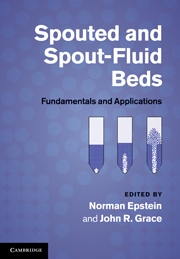Book contents
- Frontmatter
- Contents
- Contributors
- Preface
- Common nomenclature
- 1 Introduction
- 2 Initiation of spouting
- 3 Empirical and analytical hydrodynamics
- 4 Computational fluid dynamic modeling of spouted beds
- 5 Conical spouted beds
- 6 Hydrodynamics of spout-fluid beds
- 7 Spouted and spout-fluid beds with draft tubes
- 8 Particle mixing and segregation
- 9 Heat and mass transfer
- 10 Powder–particle spouted beds
- 11 Drying of particulate solids
- 12 Drying of solutions, slurries, and pastes
- 13 Granulation and particle coating
- 14 The Wurster coater
- 15 Gasification, pyrolysis, and combustion
- 16 Spouted bed electrochemical reactors
- 17 Scaleup, slot-rectangular, and multiple spouting
- 18 Mechanical spouting
- 19 Catalytic reactors and their modeling
- 20 Liquid and liquid–gas spouting of solids
- Index
- References
7 - Spouted and spout-fluid beds with draft tubes
Published online by Cambridge University Press: 04 February 2011
- Frontmatter
- Contents
- Contributors
- Preface
- Common nomenclature
- 1 Introduction
- 2 Initiation of spouting
- 3 Empirical and analytical hydrodynamics
- 4 Computational fluid dynamic modeling of spouted beds
- 5 Conical spouted beds
- 6 Hydrodynamics of spout-fluid beds
- 7 Spouted and spout-fluid beds with draft tubes
- 8 Particle mixing and segregation
- 9 Heat and mass transfer
- 10 Powder–particle spouted beds
- 11 Drying of particulate solids
- 12 Drying of solutions, slurries, and pastes
- 13 Granulation and particle coating
- 14 The Wurster coater
- 15 Gasification, pyrolysis, and combustion
- 16 Spouted bed electrochemical reactors
- 17 Scaleup, slot-rectangular, and multiple spouting
- 18 Mechanical spouting
- 19 Catalytic reactors and their modeling
- 20 Liquid and liquid–gas spouting of solids
- Index
- References
Summary
The draft tube spout-fluid bed (DTSFB) is an extremely versatile fluid–particle system that can be widely applied industrially. This configuration aids performance because control of the fluid residence time and solid cycle time distributions can be accomplished easily. Thus understanding the solid and fluid phase hydrodynamics is essential to optimizing DTSFB operation.
A typical DTSFB system consists of four interconnected zones, as shown in Figure 7.1: a spout-fluid bed feeder, a moving bed annulus, a draft tube (pneumatic conveyor), and a freeboard fountain. For a given geometry and particles, five control quantities determine the bed hydrodynamics: the inlet jet fluid mass flowrate, Fj0; the inlet auxiliary fluid mass flowrate, Fax0; the internal annulus fluid mass flowrate, Fa; the inlet section length, Li; and the annulus height, Ha. The draft tube inlet length, Li, controls both the fluid leakage and solids crossflow. The auxiliary fluid mass flow, Fax0, controls the pressure drop across the bed and alters the internal solids flow. To describe the overall and local dynamics of such systems, appropriate fluid and particle models must be devised for each separate region of the DTSFB. The discussion in this chapter addresses operating characteristics, applications, and design concepts. Initially we focus on the basic hydrodynamic features of these systems, and then we provide an overview of applications involving the basic DTSFB and novel hybrid configurations.
- Type
- Chapter
- Information
- Spouted and Spout-Fluid BedsFundamentals and Applications, pp. 128 - 140Publisher: Cambridge University PressPrint publication year: 2010
References
- 2
- Cited by



